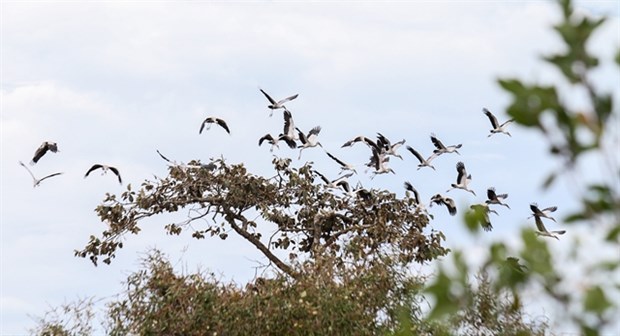
Lo Go - Xa Mat National Park saw a rare flock of 1,000 storks migrating to the forest. (Photo: VNA)
There are 934 different species of plants, along with 42 species of mammals, 203 bird species and 53 reptile species that have been recorded across the park’s area of 30,000 hectares.
It is also in the Lo Go - Xa Mat National Park that scientists found the nepenthes thorelii, or Thorel pitcher plant, which was thought to have been extinct for 100 years and is now classified as an endemic species.
The park also saw a rare flock of more than 1,000 storks migrate to the forest last summer. There haven't been many flocks of this size that stayed at the park for an extended period of time.
To protect this rare flock of storks, the park’s management board has closely monitored the situation and arranged patrols and provide guidance to minimise noise and negative effects on the birds, said Pham Xuan Thanh, director of the park’s Centre for Education and Forest Environment Services.
Several other rare animals residing in Lo Go - Xa Mat National Park include the black-shanked douc langur, the Indochinese silver langur, the sun bear, the red wolf, and the small loris, as well as the stump-tailed macaque, the lesser adjutant, the grey-cheeked tit-babbler, among others.
In addition to wildlife rescue, the park’s Department of Conservation Science and International Cooperation also takes care of several pheasants and Indian peafowls for research and educational purposes.
Thanh told Nong nghiep (Agriculture) newspaper: “We are not only working to conserve the existing species but also receive rescued wildlife, taking care of them and releasing them back to nature at Lo Go - Xa Mat.”
The national park also offers a wide range of activities for visitors, including sightseeing around the signature forest habitats, cycling along a 24km route through the woods, and learning about the wartime Central Office for South Vietnam, which was based in the forest area.
Thuy, one of the 30-people group travelling to Lo Go - Xa Mat said: “Life is full of hustle and bustle, so being in the forest calms us down and lets us immerse ourselves in nature.”
Having walked through 10km in the national park, Bich Hong is still full of energy and excited about the experience.
She said: “This is the first time I've visited Lo Go - Xa Mat National Park. It's an eco-tourism spot that still keeps its natural values.
“I hope that the park’s staff will always maintain these natural characteristics.”
According to Au Phuoc Quy, chief of the local forest rangers, the national park is better protected thanks to tourism activities.
He said: “Forest rangers are always on patrol even without eco-tourism. But in addition to law enforcers, the daily presence of dozens of visitors also discourages potential criminals and helps detect wrongdoings.”
Since the locality boosted tourism to the national park in 2016, forest violations have witnessed a significant decrease and are not as alarming as in the past.
The People’s Committee of Tay Ninh province has also approved two projects on eco-tourism and on developing the buffer zone of Lo Go - Xa Mat National Park in the 2023-30 period.
The objective is to invest and effectively utilise the tourism potential of the area, while also preserving its natural values and ecological environment.
Lo Go - Xa Mat National Park expects to welcome 40,000 visitors per year by 2023, which is estimated to bring in 52 billion VND (2.2 million USD) in annual revenue./.
VNA
 Vietnam sees record foreign tourist arrivals despite stormy season
Vietnam sees record foreign tourist arrivals despite stormy season



